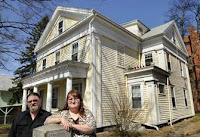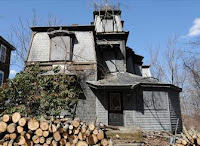








Orphaned jewels
Pressure builds to tear down endangered buildings
WHERE WE LIVE
By Richard Price SPECIAL TO THE TELEGRAM & GAZETTE
WORCESTER — Here is a real estate ad one will never see: “Motivated seller! This stunning house of prayer is in move-in shape. Conveniently located in Salem Square, it offers cathedral ceilings, an Italian marble altar and twin spiral towers. This is a true handyman’s dream that comfortably seats 1,300 people. Originally priced at $7 million, now $1.6 million.”
When the Notre Dame des Canadiens closed last July because of a steady decline in church attendance and priesthood enrollment, the Worcester Diocese was left with a majestic cathedral built in 1929 that needed several million dollars in repairs just to shore up its roof and walls, said Monsignor Thomas Sullivan, the diocesan chancellor. It has no buyer or prospects despite numerous presentations to other church groups, the city, museums and colleges. It now makes its debut on the 2009 list of Preservation Worcester’s 10 most endangered structures. Updated every year and published for 15 years, the list from the 40-year-old organization focuses mostly on distressed buildings with a mix of history, culture and architectural curb appeal.
Although many of the properties listed have been in serious decline for years, Preservation Worcester hopes this year will be different. But with tight bank credit and a deep recession, the chance of these fragile links to Worcester’s past getting a full makeover and return to their architectural glory is dimming.
“I would think that it would be harder for anyone to maintain because of the economy,” said Deborah Packard, executive director of Preservation Worcester. Its endangered list is kept to 10 — though there are hundreds more structures that qualify — partly so the organization can stay focused on the owners of the buildings most in need.
Worcester is not alone. Although state and federal tax credits are still in place for preserving historical structures, there are fewer buyers on the market and abandonment is a problem.
“With the rate of housing foreclosure in the Northeast, we are concerned about the stability of historic and older neighborhoods, in particular urban neighborhoods,” said Wendy Nicholas, director of the Northeast regional office for the National Trust for Historical Preservation.
Ms. Nicholas added that when historic homes deteriorate badly, neighbors get nervous, upset and put pressure on city hall to demolish. “It is a bad downward spiral,” she said.
The Bentley-Jackson Cottage at 9 Earle St. is a good example. Although listed on the National Register of Historic Places, it looks more like ancient ruins. It has rotted siding, broken windows and a sunken porch. Its yard is a magnet for illegal dumping. On one particular day a three-legged black cat was poking around an abandoned Honda Civic, next to a rusty camper laying face down, empty paint buckets and a gutted easy chair.
“This is disgusting,” said Maria Dellostritto, who has lived next door for 30 years. Her yard is in stark contrast: green and spotless with a row of flowers on the property line. Ms. Dellostritto has complained to the city countless times about the Bentley-Jackson Cottage: a phone call about the 5-foot grass, another about the abandoned car and one about a skunk that moved in. Her frustration with the city peaked five years ago and she considered selling her house. “I was tired of dealing with it,” she said. “Clean it up, tear it down, whatever.”
That is almost the message from Khalid Saeed, professor of economics and system dynamics at Worcester Polytechnic Institute. He said many of the original homes like the Bentley-Jackson Cottage were built for the rich who controlled the factories and mills of this once industrial town. Today, he said, the city embraces education and high-tech industries by converting old factories into apartments, restaurants and office space.
He believes that houses rich with history and aesthetic appeal can be helped if offered for sale at good prices, with low property taxes and agreeable restoration laws. Otherwise, it would better serve the community to tear them down and rezone for business that will boost tax revenues, improve city services and raise property values. “This is what happened in Boston in the 1970s,” he said, acknowledging that bulldozing entire neighborhoods is controversial.
Frederick A. Webber, 51, lives in the S.D. Newton House at 8 Sycamore St. Sold at a bank foreclosure in December 2007, the building has an exterior in desperate need of repair. Mr. Webber hopes to begin restoration as soon as grant money arrives.
An admitted Internet junkie, he saw a photo of the 1849 house, with its Greek Revival architecture and four Doric columns, on the bank’s Web site. “It was one of those photos that captures your eye,” he said. Over the years, he said he has bought homes this way, made repairs, then sold for a profit.
This house, he says, he will live in forever. “I’d love to see the original blueprints.”
When the Notre Dame des Canadiens closed last July because of a steady decline in church attendance and priesthood enrollment, the Worcester Diocese was left with a majestic cathedral built in 1929 that needed several million dollars in repairs just to shore up its roof and walls, said Monsignor Thomas Sullivan, the diocesan chancellor. It has no buyer or prospects despite numerous presentations to other church groups, the city, museums and colleges. It now makes its debut on the 2009 list of Preservation Worcester’s 10 most endangered structures. Updated every year and published for 15 years, the list from the 40-year-old organization focuses mostly on distressed buildings with a mix of history, culture and architectural curb appeal.
Although many of the properties listed have been in serious decline for years, Preservation Worcester hopes this year will be different. But with tight bank credit and a deep recession, the chance of these fragile links to Worcester’s past getting a full makeover and return to their architectural glory is dimming.
“I would think that it would be harder for anyone to maintain because of the economy,” said Deborah Packard, executive director of Preservation Worcester. Its endangered list is kept to 10 — though there are hundreds more structures that qualify — partly so the organization can stay focused on the owners of the buildings most in need.
Worcester is not alone. Although state and federal tax credits are still in place for preserving historical structures, there are fewer buyers on the market and abandonment is a problem.
“With the rate of housing foreclosure in the Northeast, we are concerned about the stability of historic and older neighborhoods, in particular urban neighborhoods,” said Wendy Nicholas, director of the Northeast regional office for the National Trust for Historical Preservation.
Ms. Nicholas added that when historic homes deteriorate badly, neighbors get nervous, upset and put pressure on city hall to demolish. “It is a bad downward spiral,” she said.
The Bentley-Jackson Cottage at 9 Earle St. is a good example. Although listed on the National Register of Historic Places, it looks more like ancient ruins. It has rotted siding, broken windows and a sunken porch. Its yard is a magnet for illegal dumping. On one particular day a three-legged black cat was poking around an abandoned Honda Civic, next to a rusty camper laying face down, empty paint buckets and a gutted easy chair.
“This is disgusting,” said Maria Dellostritto, who has lived next door for 30 years. Her yard is in stark contrast: green and spotless with a row of flowers on the property line. Ms. Dellostritto has complained to the city countless times about the Bentley-Jackson Cottage: a phone call about the 5-foot grass, another about the abandoned car and one about a skunk that moved in. Her frustration with the city peaked five years ago and she considered selling her house. “I was tired of dealing with it,” she said. “Clean it up, tear it down, whatever.”
That is almost the message from Khalid Saeed, professor of economics and system dynamics at Worcester Polytechnic Institute. He said many of the original homes like the Bentley-Jackson Cottage were built for the rich who controlled the factories and mills of this once industrial town. Today, he said, the city embraces education and high-tech industries by converting old factories into apartments, restaurants and office space.
He believes that houses rich with history and aesthetic appeal can be helped if offered for sale at good prices, with low property taxes and agreeable restoration laws. Otherwise, it would better serve the community to tear them down and rezone for business that will boost tax revenues, improve city services and raise property values. “This is what happened in Boston in the 1970s,” he said, acknowledging that bulldozing entire neighborhoods is controversial.
Frederick A. Webber, 51, lives in the S.D. Newton House at 8 Sycamore St. Sold at a bank foreclosure in December 2007, the building has an exterior in desperate need of repair. Mr. Webber hopes to begin restoration as soon as grant money arrives.
An admitted Internet junkie, he saw a photo of the 1849 house, with its Greek Revival architecture and four Doric columns, on the bank’s Web site. “It was one of those photos that captures your eye,” he said. Over the years, he said he has bought homes this way, made repairs, then sold for a profit.
This house, he says, he will live in forever. “I’d love to see the original blueprints.”
 I was tired of dealing with it. Clean it up, tear it down, whatever.
I was tired of dealing with it. Clean it up, tear it down, whatever. 
-- maria dellostritto, NEIGHBOR OF HISTORIC HOME
No comments:
Post a Comment